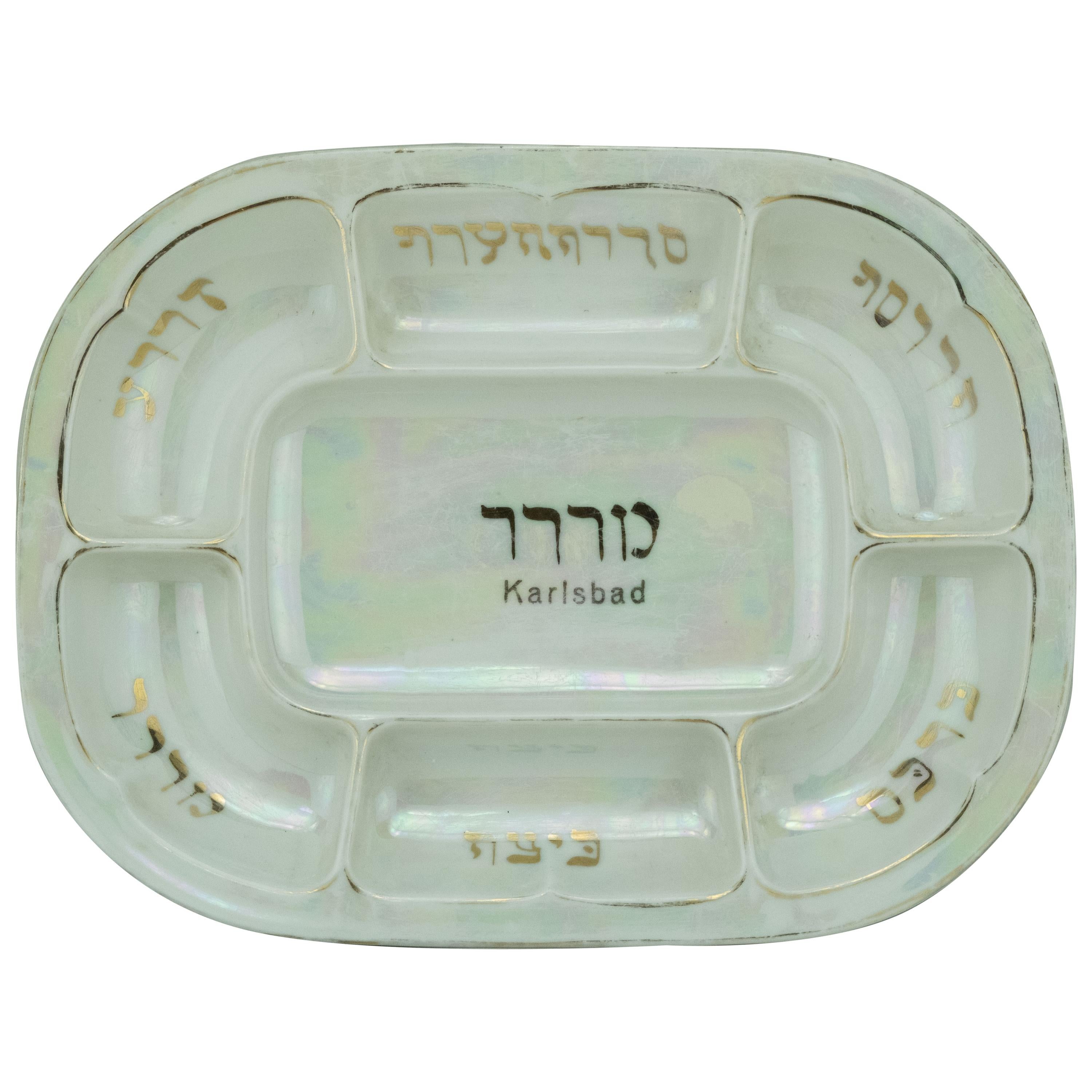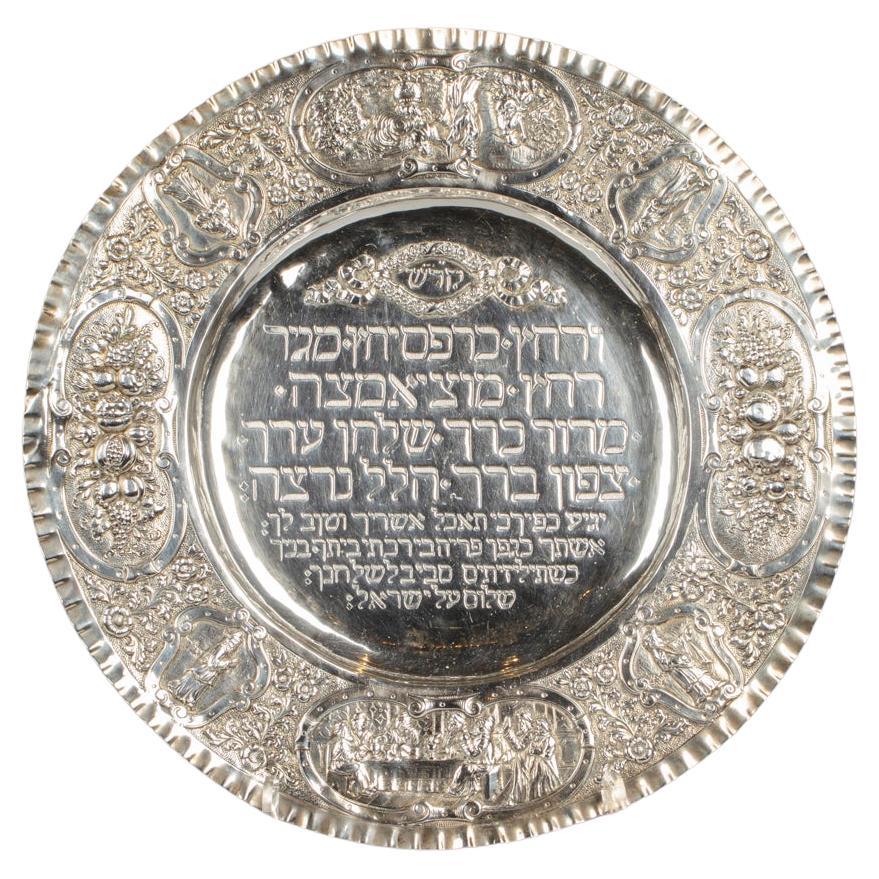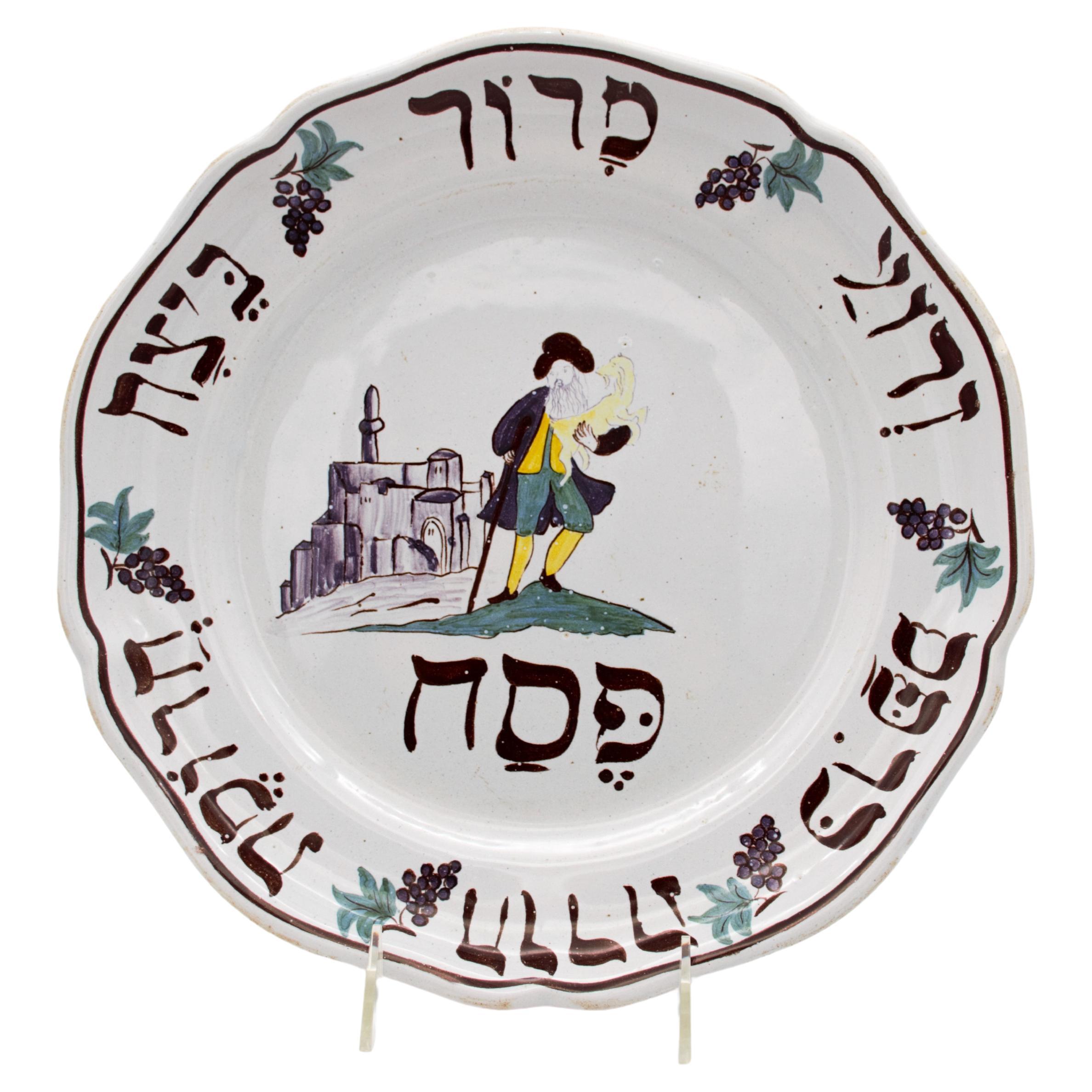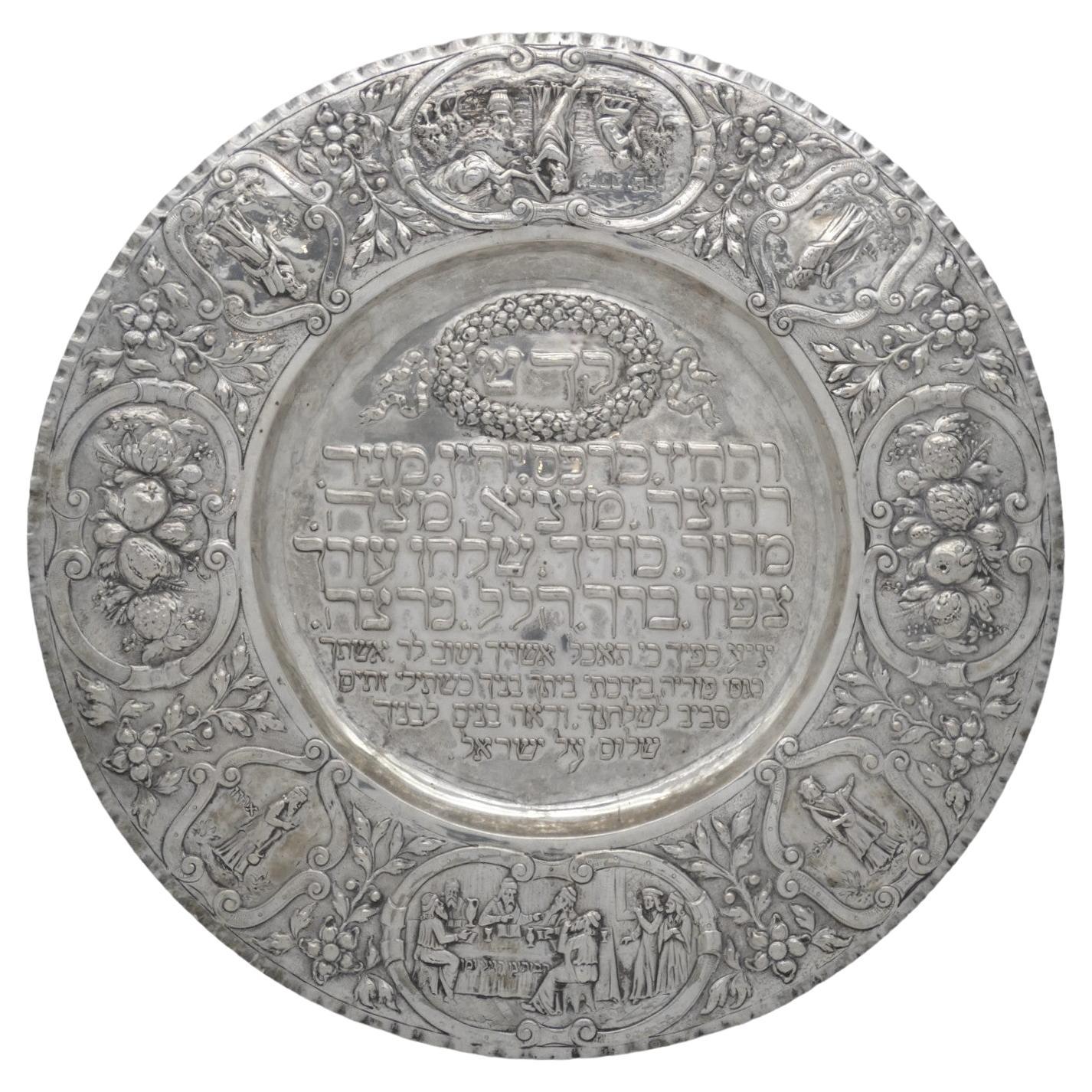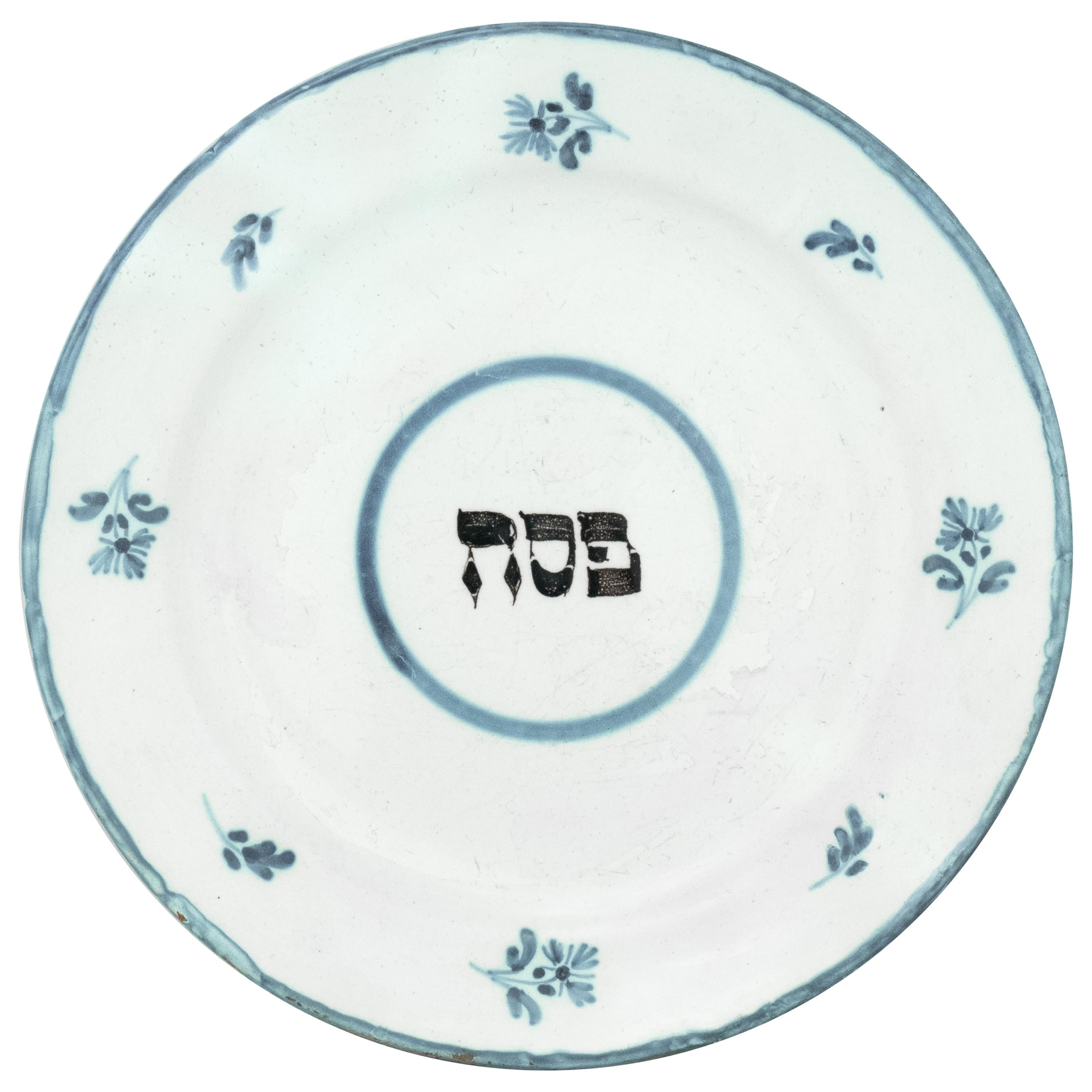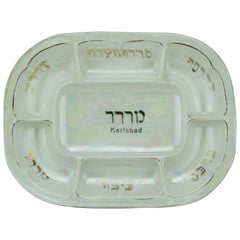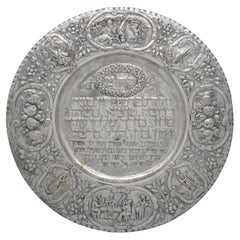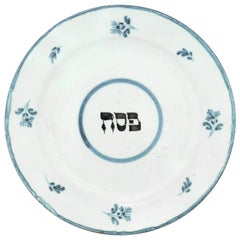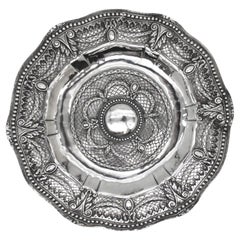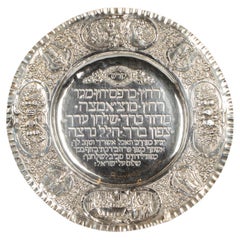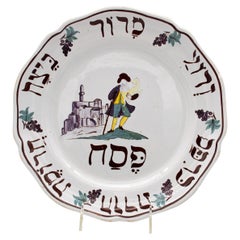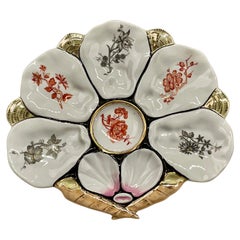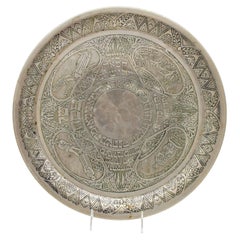Items Similar to A Porcelain Seder Plate, Karlsbad, early 20th Century
Want more images or videos?
Request additional images or videos from the seller
1 of 7
A Porcelain Seder Plate, Karlsbad, early 20th Century
$1,250
£949.48
€1,094.12
CA$1,760.31
A$1,951.56
CHF 1,025.62
MX$23,883.94
NOK 12,808.99
SEK 12,022.51
DKK 8,166.92
About the Item
An intriguing and highly uncommon example of early 20th-century Judaica, this porcelain Seder plate—crafted in the celebrated ceramics region of Karlsbad (then part of the Austro-Hungarian Empire, now Karlovy Vary, Czech Republic)—is both artistically and historically noteworthy.
The plate is distinctively shaped like a scalloped shell, a design rarely seen in traditional Seder plates, and is edged with five individual bowl-like indentations, each designated with the name of a traditional Passover food item: זרוע (Z’roa), חרוסת (Charoset), מרור (Maror), and פסח (Pesach), with the central and largest compartment bearing the inscription של חג הפסח (“For the Festival of Passover”)—all delicately painted in gold Hebrew script. Interestingly, beneath the main inscription appears the name “Karlsbad”, also in gold—linking the plate to the famous spa and vacation town known as a holiday destination for German Jews.
The inclusion of only five compartments (effectively four, as פסח and זרוע are typically synonymous) is a notable deviation from the conventional six-part layout of Seder plates, reflecting either a regional interpretation or a simplified tourist adaptation. This, along with the elegant mother-of-pearl iridescent glaze that shimmers across the porcelain surface and is punctuated by refined gold-painted detailing, hints that this piece may have been created not just for ritual use, but also as a commemorative or decorative object for travelers visiting Karlsbad.
A stamp on the reverse confirms Czech manufacture, suggesting the plate was likely made locally but intended for sale or gifting to Jewish tourists frequenting the German-speaking spa town.
This fusion of artistic elegance, ritual tradition, and cross-cultural Jewish history makes this Seder plate a truly uncommon and captivating artifact of Jewish life in Central Europe during the early 1900s.
Marked at bottom
- Dimensions:Height: 1.38 in (3.5 cm)Width: 9.73 in (24.7 cm)Depth: 7.09 in (18 cm)
- Materials and Techniques:Porcelain,Glazed
- Place of Origin:
- Period:
- Date of Manufacture:Early 20th Century
- Condition:Wear consistent with age and use.
- Seller Location:New York, NY
- Reference Number:1stDibs: LU5281245096852
About the Seller
5.0
Recognized Seller
These prestigious sellers are industry leaders and represent the highest echelon for item quality and design.
Established in 2006
1stDibs seller since 2020
134 sales on 1stDibs
Typical response time: 8 hours
- ShippingRetrieving quote...Shipping from: Pomona, NY
- Return Policy
Authenticity Guarantee
In the unlikely event there’s an issue with an item’s authenticity, contact us within 1 year for a full refund. DetailsMoney-Back Guarantee
If your item is not as described, is damaged in transit, or does not arrive, contact us within 7 days for a full refund. Details24-Hour Cancellation
You have a 24-hour grace period in which to reconsider your purchase, with no questions asked.Vetted Professional Sellers
Our world-class sellers must adhere to strict standards for service and quality, maintaining the integrity of our listings.Price-Match Guarantee
If you find that a seller listed the same item for a lower price elsewhere, we’ll match it.Trusted Global Delivery
Our best-in-class carrier network provides specialized shipping options worldwide, including custom delivery.More From This Seller
View AllEarly 20th Century Czech Porcelain Passover Seder Plate
Located in New York, NY
Unusual oval shape Seder plate, Karlsbad, Czechoslovakia, circa 1900.
Divided into seven wells and inscribed with gold lettering and border with the order of the Seder.
Signed on t...
Category
Early 20th Century Czech Porcelain
Materials
Porcelain
$660 Sale Price
38% Off
A Large Silver Passover Seder Plate by Gutgesell Gebrüder, Hanau Circa 1915
Located in New York, NY
A Large Chased Silver Passover Seder Plate made by Gutgesell Gebrüder in Hanau, circa 1915, is a very noteworthy piece of Judaica. Most seder plates were made with a cast and mass-pr...
Category
Early 20th Century Sterling Silver
Materials
Silver
$6,400 Sale Price
20% Off
Early 18th Century Dutch Tin-Glazed Earthenware Passover Plate
Located in New York, NY
18th century tin-glazed earthenware Passover plate, Delft, the Netherlands.
Decorated with a foliate design in light blue, the Hebrew word "Pesach" (Pas...
Category
Antique Early 18th Century Dutch Religious Items
Materials
Earthenware
$1,910 Sale Price
20% Off
An Italian Silver Passover Seder Plate, Venice Circa 1800
Located in New York, NY
This magnificent Italian silver Passover Seder plate, crafted in Venice circa 1800, is a striking example of refined silversmith artistry combined with deep ritual significance. Made...
Category
Antique Early 1800s Italian Sterling Silver
Materials
Silver
An American Porcelain Passover Salt Water Dish, Circa 1920
Located in New York, NY
An American egg-shaped porcelain Passover salt water dish with a matching ladle from circa 1920 reflects American artistic trends of the 1920s, blending traditional Jewish themes with modern aesthetics.
The early 20th century saw significant Jewish immigration to the United States, particularly from Eastern Europe.
Porcelain was a popular material for decorative and functional items during this period, known for its delicate and refined qualities. American manufacturers were producing high-quality porcelain pieces, a material prized for its beauty and fine texture, and often influenced by European styles.
This lovely dish rests on three legs painted with foliate designs, outlined with gold-lined patterns, applied to the underside of the egg-shaped container. The opening at the top is jagged and resembles a cracked egg, with a large ladle...
Category
Vintage 1920s American Porcelain
Materials
Porcelain
$1,440 Sale Price
20% Off
A Rare Silver Passover Seder Plate, Austria 1844 Judaica
Located in New York, NY
A Rare Silver Passover Seder Plate, Austria 1844
Circular outer rim supports wirework stems connected to a central knop and oblong shaped handle. Six bowls sit on round hanging suppo...
Category
Antique 1840s Sterling Silver
Materials
Silver
You May Also Like
German Silver Seder Plate, Early 20th century
Located in New York, NY
The well embossed with Hebrew blessings, the wide border with two large quatrefoil panels with scenes of the sacrifice of Isaac and the Five Rabbis of Benei Brak, alternating with tw...
Category
Early 20th Century Sterling Silver
Materials
Silver
French faience Passover plate, JUDAICA 19th century
Located in Tel Aviv - Jaffa, IL
this plate has a creme white background, the center painted with a man holding a lamb before a cityscape, probably a depiction of Jerusalem by someone who never actually visited the city or even see it, under the man there is the word Passover "פסח" the rim with the order of the Seder, and some grape vines between them.
Passover, also called Pesach ( Biblical Hebrew: חַג הַפֶּסַח, romanized: Ḥag haPesaḥ), is a major Jewish holiday, one of the three pilgrimage festivals, that celebrates the Biblical story of the Israelites' escape from slavery in Egypt.
Pesach starts on the 15th day of the Hebrew month of Nisan which is considered the first month of the Hebrew year. The Hebrew calendar...
Category
Antique Late 19th Century French Victorian Platters and Serveware
Materials
Pottery
19th c. Porcelain Oyster Plate
Located in Winter Park, FL
A late 19th century porcelain oyster plate made by the Union Porcelain Works of Greenpoint, New York. Hand-painted with gilt accents. Nicely shaped and molded with five shallow well...
Category
Antique Late 19th Century Porcelain
Materials
Ceramic
Decorative Judaica Passover plate by Heinrich Schwed. Munich, 1924.
Located in Tel Aviv - Jaffa, IL
Decorative Passover plate by Heinrich Schwed. Munich, 1924.
ALPACA, etched.
This Large plate, featuring a round medallion in the center, with a Matzah which in this plate is hand c...
Category
Vintage 1920s Platters and Serveware
Materials
Alpaca
Antique German KPM Royal Berlin Porcelain Hand-Painted Oyster Plate
By Kerafina Royal Porzellan KPM
Located in Atlanta, GA
Antique German KPM Royal Berlin Porcelain Hand-Painted Oyster Plate with six wells.
The KPM Royal Berlin factory, renowned for producing fine porcelain since the 18th century, is hi...
Category
Antique 1890s German Victorian Porcelain
Materials
Porcelain
Kähler Ceramic Dish
Located in Kastrup, DK
Kähler ceramic dish decorated in polychrome glaze.
Signed: HÄK (Herman A. Kähler).
Denmark 1930 - 1940.
Category
Mid-20th Century Danish Modern Centerpieces
Materials
Ceramic
More Ways To Browse
Iridescent Plate
Gold Scallop Shell
Antique Judaica Silver
Scalloped Gold Bowl
Antique Czech Porcelain
Glass Shell With Pearl
Commemorative Ceramics
Hungarian Cross
Scalloped Shell Bowl
Seder Plate
Seder Silver
Passover Seder Plate
Silver Seder Plate
Passover Silver
Antique Seder Plate
Antique Passover Seder Plate
Karlsbad Porcelain
Limoges France Porcelain Cobalt Blue
